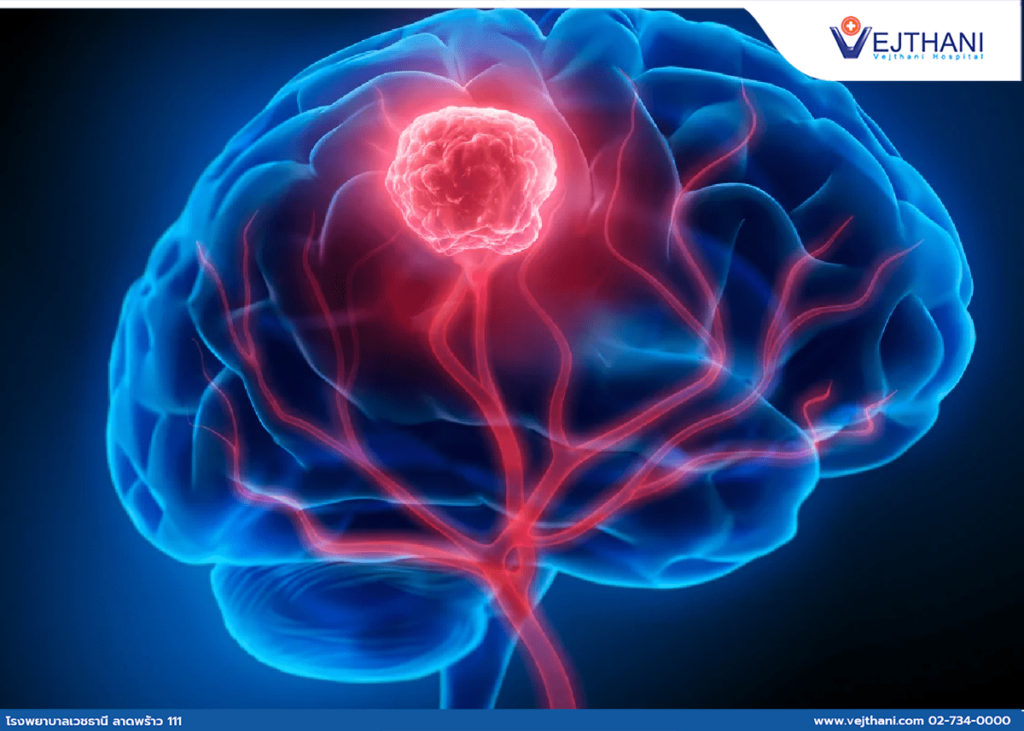

Persistent headaches, slurred speech, facial asymmetry, and limb weakness may be among the signs of a “brain tumor” that some people may not be aware of. If not treated promptly, it can lead to serious consequences, such as Hemiplegia or cancer metastasizing in the dangerous stage.
According to Dr. Pongsakorn Pongsapas, a neurosurgeon at Vejthani Hospital, brain tumors are caused by genetic structural abnormalities. It is essential to determine where the tumor is located and what function that area performs to identify the symptoms that may arise. For instance, a brain tumor in the visual area can result in blurred or double vision, while a tumor that affects the movement control of the limbs can cause weakness or Hemiplegia. Brain tumors can be either benign or malignant, which is also known as brain cancer.
Benign brain tumors arise from genetic abnormalities in the brain cells or mutation of cells. These abnormalities can cause brain cells to divide and grow abnormally. The abnormal growth of these mutated cells can develop into benign tumors in the brain, potentially causing damage to the brain and nervous systems.
Malignant or brain cancer tumors can develop from cancer cells that originated in the brain or from cancer cells that have spread from other organs into the brain through the bloodstream. This results in the growth of malignant tumors with abnormal growth rates, resulting in more severe damage to the body than benign tumors.
Symptoms of Brain Tumors:
- Frequent, chronic headaches that worsen
- Nausea, vomiting, and persistent drowsiness
- New onset seizures
- Hearing problems
- Communication difficulties, slurred speech
- Memory problems, confusion
- Vision problems, blurry or double vision
- Imbalance
- Changes in mental and behavioral aspects
- Loss of sensation and mobility in limbs
- Weakness of arms and legs or paralysis on one side of the body
The diagnosis begins with a comprehensive medical history, physical examination, and various brain function tests using Computed Tomography (CT) scans or Magnetic Resonance Imaging (MRI) with electromagnetic waves. These techniques offer detailed images of blood vessels and nerves, allowing for a swift and accurate diagnosis to plan appropriate treatment.
The treatment for a brain tumor depends on its size, location, and type. Your doctor may recommend regular monitoring if the tumor is small and poses no immediate danger to the brain or nervous system. However, if the tumor is large, surgery can be considered to remove the brain tumor.
Currently, we can accurately diagnose vascular diseases with the aid of a remarkable tool called Biplane Digital Subtraction Angiography (Biplane DSA). This sophisticated machine uses X-ray to navigate a thin catheter directly into the brain’s blood vessels. With pinpoint precision, the catheter is inserted into specific blood vessels, effectively blocking the blood supply to the tumor. This hinders the tumor’s growth from reduced blood flow 5and paves the way for its safer, more efficient surgical removal.
Biplane DSA enhances the effectiveness of destroying brain tumors and minimizes the risk of surgical complications. Minimal bleeding allows for a swifter recovery, a welcome comfort for patients on their journey to healing.
While there’s currently no guaranteed way to prevent brain tumors, understanding your risk factors and being aware of potential symptoms can be crucial. Be mindful of unusual neurological changes or any family history of brain tumors. If you notice any abnormalities, promptly seek professional medical evaluation, as early diagnosis and intervention significantly improve the chances of effective treatment and positive outcomes.
For more information, please contact
Neuroscience Center, Vejthani Hospital.
Tel. 02-734-0000 Ext. 5400
English Hotline: (+66)8-522 38888
- Readers Rating
- Rated 4.9 stars
4.9 / 5 ( Reviewers) - Spectacular
- Your Rating

























